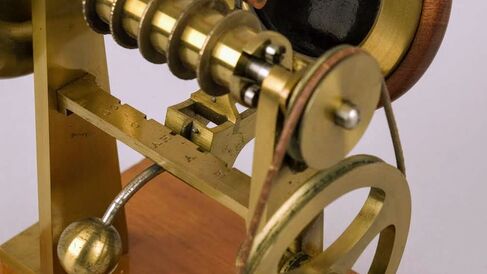Stroh's Automatic Phonograph

This vowel sounder, known as an "automatic phonograph", from the Whipple Museum's collection was designed by the German-born engineer J. M. Augustus Stroh (1828-1914) and built by W. Groves. It is one of the many so-called 'talking machines' that were constructed in the late 19th and early 20th centuries, along with Helmholtz's synthesizer and eventually Edison's phonograph. This was a period of great public and scientific interest in the potential for the recording and transmission of sound. This machine was used by William Preece and Augustus Stroh in demonstration of their paper Studies in Acoustics: On the Synthetic Examination of Vowel Sounds to the Royal Society in February 1879.
Visit the Whipple Library for a special display of pamphlets, books, models and ephemera relating to phrenology with the Whipple Museum of the History of Science. Investigate the products of the nineteenth-century pseudoscience that declared personal characteristics were represented by the shape of your head. Gain a better understanding of the humorous misunderstandings as well as problematic misuses of the quack science that preceded psychology, and follow guides for your own phrenological diagnosis.
Free, drop in. Adults.
Location: Whipple Library
The Main Gallery
Formerly the 17th century Perse Room, the Whipple Museum's Main Gallery houses selected objects from our large collection. As well as large instruments - such as the 18th century Grand Orrery built by George Adams, and William Herschel's Newtonian telescope - there are a number of themed cases. These contain many exhibits associated with a variety of scientific fields. The gallery also hosts Case Studies, individual contributions by members of the Department of History and Philosophy of Science that display current research or areas of personal interest.
Our latest display in this gallery is Physics & Glass, featuring objects from the Cavendish Museum and the Whipple's own collection.
Special Exhibition Gallery
The current exhibition in the Special Exhibition Gallery is Robert S. Whipple and the Founding of the Whipple Museum, celebrating our 75th Anniversary.
This followed on from our first special exhibition in the refurbished space, Astronomy and Empire, which was on from 2nd October 2017 until 28th September 2019.
The Learning Gallery
This Learning Gallery is next door to the Main Gallery, and features exhibits related to study and learning.
Importantly, it also contains family-friendly resources! Our activity boxes contain handling objects that help illustrate scientific concepts in an enjoyable way.
Globes in the Upper Gallery
The Upper Gallery features our stunning permanent exhibition: Globes. Often light-sensitive, globes are challenging to display, not least because it is desirable, but difficult, to see the entire surface of the globe. Our cases allow visitors a complete 360° view of our oustanding collection of globes, planetaria and other related objects. This has been part-funded by DCMS/Wolfson.
Learn more about Globes in our Exploresection.
The Victorian Parlour
Upstairs in the Museum is the Victorian Parlour. This mini-gallery evokes the parlour of a 19th-century family interested in science. The room is filled with scientific objects which might have been found in the home during this period. Explore the drawers to find many 19th-century activities and games with a scientific theme - have fun designing your own animations using the zoetrope or look at early 3D images with the stereoscopic viewer.
How it works
The automatic phonograph was used to imitate five different vowels. Five discs, mounted on a rotating axle, are cut with grooves resembling the sound waves associated with various vowel sounds. When the axle rotates one of the discs rubs against a thin metal rod transmitting the ensuing vibrations to a circular diaphragm. This results in an audible sound being produced. The metal rod and diaphragm are able to slide between the five discs depending on which vowel sound is required (the machine is inscribed with 'oo', 'o', 'ah', 'a', 'e').
Invention
Hermann von Helmholtz (1821-1894) argued that vowels are compound tones, defined by the combination of non-harmonic resonances known as formants. The nature of the vowel depends on the relative intensities of these different formants, which in turn depend of the positioning of the vocal tract. The grooves in the discs of this machine are cut in such a way as to cause the vibrations of the diaphragm to reflect the combination of frequencies found in vowel sounds, resulting in the production of a similar sound.
Stroh built four talking machines in early 1878, the third of which was this phonograph. The second machine etched the sound waves of the formants of vowel sounds onto the brass discs used in the phonograph, and the fourth played discs with complete words such as 'mama' and 'papa'. One year earlier, Thomas Alva Edison (1847-1931) had made his first phonograph, a device for recording and replaying sound that also used the idea of spiral discs. However, Stroh's research focused more on the scientific understanding of the composition of sound rather than Edison's more popular appeal.
Horny violins
History also remembers Stroh today for his invention of the Stroh violin, patented in 1899, which looks at first glance to be a hybrid of a violin and a trumpet (Image 2). He invented this instrument in response to the growing market for recorded music. At this time recording technologies required a powerful and focused sound source, but conventional string instruments with their hollow wooden resonator bodies produced a relatively low volume that was highly dispersed. The Stroh violin uses a metal resonator and horn to amplify and direct the sound of the strings, thus producing much more volume than conventional wooden-body string instruments. This also made the instruments popular in jazz bands and in small theatre settings, where they could be heard without amplification. The smaller horn points toward the player so that they can hear the instrument clearly.
Jonah Lipton, Torben Rees, Alison Rabinovici & Derek Scurll
Jonah Lipton, Torben Rees, Alison Rabinovici & Derek Scurll, 'Stroh's automatic phonograph', Explore Whipple Collections, Whipple Museum of the History of Science, University of Cambridge, 2009
